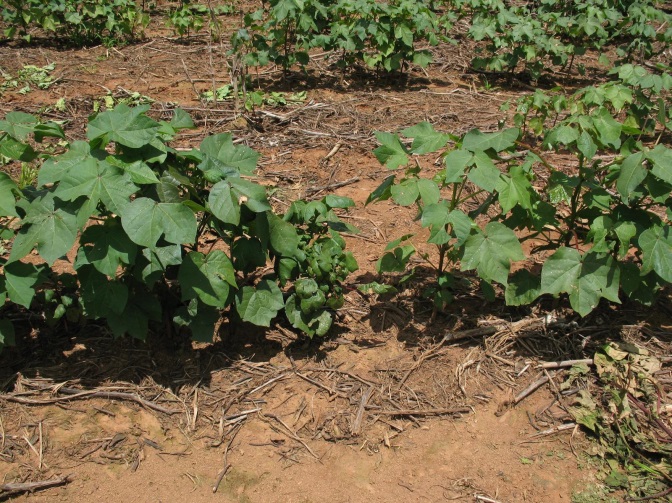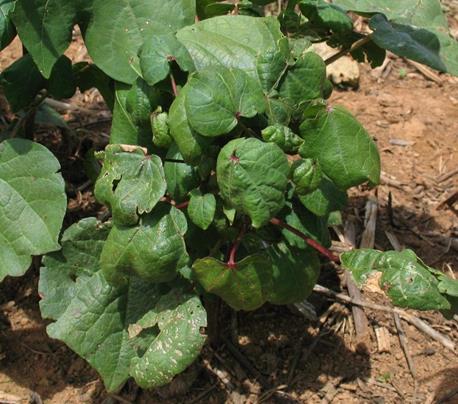
Cotton blue disease
| Primefact number | Edition | Published | Author |
|---|---|---|---|
| 1409 | First | May 2015 | Plant Biosecurity and Product Integrity |


Cotton blue disease (Cotton leafroll dwarf virus) is an exotic plant pest not present in Australia. This virus is a serious threat to Australia’s cotton industry.
Cotton blue disease, also known as cotton leafroll disease, is caused by Cotton leafroll dwarf virus and can result in severe stunting of cotton plants.
The virus is transmitted between susceptible cotton varieties by cotton aphid (Aphis gossypii).
Different cotton varieties vary in their susceptibility to cotton blue disease. All current commercially available varieties in Australia are likely susceptible.
Infected plants that become stunted can be overgrown by neighbouring healthy plants (Figure 1).
Notifiable status
Cotton blue disease (Cotton leafroll dwarf virus) is not a notifiable plant disease in NSW.
However, if you suspect Cotton blue disease (Cotton leafroll dwarf virus):
- Call the Exotic Plant Pest Hotline 1800 084 881
- Email biosecurity@dpi.nsw.gov.au with a clear photo and your contact details
A full list of notifiable plant pests and diseases can be found in Schedule 2 of the NSW Biosecurity Act 2015.
Description
Symptoms of cotton blue disease only affect new growth of a cotton plant so are first seen at the top of the plant. Symptoms do not develop in the existing plant growth.
New leaf growth is stunted and the leaves are smaller and thicker with a leathery texture. Infected leaves have an intense green colour that may appear bluish. Young leaves may also have obvious yellow veins. Leaf margins curl downwards, rolling under the leaf (Figure 2).
Early or ongoing infection leads to stunted plants that produce many branches. The main stem may grow in a distinctive zig-zag pattern and side branches tend to bend and grow in a downward direction (epinasty).
Similar diseases
A related cotton disease already present in Australia, cotton bunchy top, has many similar symptoms to cotton blue disease making them difficult to tell apart in the field.
The most distinguishing symptom between the two diseases is that cotton bunchy top has characteristic pale green angular patterns around the leaf margins and darker green centres (mottle). Cotton blue disease affected plants do not display mottle.
Damage
Cotton plants infected with cotton blue disease are stunted and produce poorer quality lint. Yield is reduced due to fewer, smaller bolls being produced and increased boll shedding.
The severity of damage varies with the susceptibility of cotton cultivars and the age of the plant at the time of infection. If susceptible cultivars are infected early in the season, productivity can be reduced by up to 80%.
Host range
Cotton blue disease affects commercial cotton (Gossypium hirsutum). Other hosts have not been well documented but are likely to include other Gossypium species and several legume species.
Spread
Cotton blue disease is transmitted by cotton aphids.
Cotton aphids are present in Australia and are known vectors of other plant viruses, such as Cotton bunchy top virus. Cotton aphids transfer cotton blue disease as they feed.
Cotton blue disease could spread to Australia in infected planting material, or with the introduction of cotton aphids carrying the disease. Once introduced, established populations of cotton aphids could help to quickly spread the virus.
Cotton blue disease is not transmissible by mechanical transfer or in seed.
Distribution
Cotton blue disease was first recorded in Africa where it is known to occur in Benin, Chad, Cameroon, Ivory Coast and the Congo. It has since been reported from Brazil, Argentina, India Thailand and Vietnam.
Actions to minimise risk
Put in place biosecurity best practice actions to prevent entry, establishment and spread of pests and diseases:
- practice “Come clean, Go clean”
- ensure all staff and visitors are instructed in and adhere to your business management hygiene requirements
- monitor your crop regularly
- monitor and control cotton aphids
- monitor and control volunteer and ratoon cotton that can harbour both the aphids and the virus
- keep records

